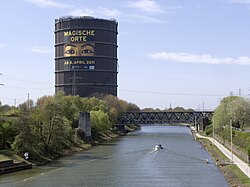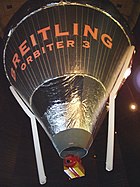Gasometer Oberhausen
This article may require copy editing for grammar, style, cohesion, tone, or spelling. (April 2024) |
 Oberhausen Gasometer | |
 | |
| General information | |
|---|---|
| Location | Oberhausen, Germany |
| Construction started | 27 February 1927 |
| Completed | 1929 |
| Inaugurated | 15 May 1929 |
| Cost | 1.74 million Reichsmarks |
| Owner | Ruhrkohle AG (1927–1992) City of Oberhausen (after 1992) |
| Height | 117.5 m (385 ft) |
| Dimensions | |
| Diameter | 67.6 m (222 ft) |
| Technical details | |
| Floor area | 7,000 m2 (75,000 sq ft) |
| Design and construction | |
| Main contractor | Gutehoffnungshütte (1927-1929) Deutsche Babcock AG (1993–1994) |
| Website | |
| http://www.gasometer.de | |
The Gasometer Oberhausen is a former gas holder in Oberhausen, Germany, which has been converted into an exhibition space. It has hosted several large scale exhibitions, including two by Christo and Jeanne-Claude. The Gasometer is an industrial landmark, and an anchor point of the European Route of Industrial Heritage and the Industrial Heritage Trail. It was built in the 1920s, and reconstructed after World War II.
History
[edit]In the 1920s the coal and steel industry in the Ruhrgebiet produced blast furnace gas and coal gas as a by-product of iron production and coking. The steel industry and coking processes used large amounts of these gasses or alternative fuels. As supply and demand of gas varied independently, sometimes excess gas had to be flared off, while at other times additional fuel had to be purchased. The Gasometer was built as a buffer: storing excess gas and releasing it again when demand exceeded production.[1]
The Gasometer was built by Gutehoffnungshütte, by the side of the Rhine-Herne Canal. Construction started 27 February 1927 and cost 1.74 million Reichsmark. A framework of 24 steel girders was built on a concrete base, and a skin of 5mm thick sheet metal was riveted to the framework. Inside, a 1,207,000 kg pressure disc was mounted which could freely move up and down, floating on top of the gas underneath and keeping it at a constant pressure. 15 May 1929 the Gasometer was first put into operation, with a maximum capacity of 347,000m³, a height of 117.5m and diameter of 67.6m.[1]
During World War II, the Gasometer was hit by bombs several times, but kept operating.[2] When it was shelled by allied forces it did not explode, but the gas burned up and the pressure disc slowly descended. The Gasometer officially stopped operating 31 December 1944. It was completely disassembled after it had caught fire during repair work on 10 June 1946. Reconstruction began 1949 using the original pressure disc and roof. By 1 June 1950 the Gasometer was operational again.[1]
In 1977 the Gasometer was repainted, at a cost of 3.5 million DM. In later years many coking plants and iron works closed, reducing supply as well as demand for the gas stored in the Gasometer. In addition, natural gas became cheaper. The Gasometer became superfluous and in 1988 it was decommissioned by its owner, Ruhrkohle AG.[1]
A discussion ensued about the dismantling or possible reuse of the Gasometer. In 1992 the city council of Oberhausen, with a margin of 1 vote decided to acquire the building and convert it to an exhibition space. At the time, plans were being developed for building shopping mall (CentrO) on an adjacent plot, and Internationale Bauausstellung Emscher Park planned to use the Gasometer for its exhibition. Ownership transferred to the city of Oberhausen, with Ruhrkohle AG paying 1.8 million DM in saved demolition costs to the city.[1]
Conversion and restoration were done by Deutsche Babcock AG from 1993 to 1994. The former pressure disc was positioned at a 4.5 m height, with a 3000 m2 exhibition space on the ground floor below. The main exhibition space, located on top of the pressure disc, was equipped with a stage and seating for 500 people. Lifts and stairs were installed to provide visitors access to the roof.[3] The conversion project cost approximately DM 16 million.[1]
Exhibitions
[edit]Fire & Flame (1994–1995)
[edit]The exhibition "Fire and Flame" documented the history of the coal and iron industry in the Ruhr area and its influence on society. It attracted about 460,000 visitors.[4]
I Phoenix (1996)
[edit]"I Phoenix" was an exhibition of contemporary art. It attracted 96,000 visitors.[4]
The Dream of Vision (1997)
[edit]The exhibition "The Dream of Vision" dealt with the history of television.[4]
Christo: The Wall (1999)
[edit]"The Wall" was organised as part of the IBA Emscher Park, at a cost of nearly 4 million DM.[5] It was an installation by Christo and Jeanne-Claude, consisting of a stack of 13,000 oil drums in 7 colours, 68m wide, 26m high, and 7m deep, and weighed 234,000 kg. It attracted 390,000 visitors.[4]
The Ball is Round (2000)
[edit]This exhibition was organised for the centenary of the German Football Association in 2000, and documented the history of football. It had 216,000 visitors.[4]
Blue Gold (2001-2002)
[edit]"Blue Gold" dealt with the subject of water. It included 833,000 kg of sand. An installation by Paul Schütze included a 50m high cone of water in an artificial lake, and video projections.[4]
Bill Viola: Five Angels for the Millennium (2003)
[edit]This was a video installation by Bill Viola. It had 140,000 visitors.[4]
Wind of Hope (2004)
[edit]
This exhibition dealt with Brian Jones and Bertrand Piccard's 1999 round–the–world balloon flight, and it displayed their 55 metres (180 ft) high Breitling Orbiter 3 balloon inside the Gasometer.[4]
Fire Light Sky (2006)
[edit]
"Fire Light Sky" was an installation of sound and light by Christina Kubisch, combined with an exhibition about the history of the Gasometer.[4]
The Eye in the Sky (2007-2008)
[edit]This exhibition was a cooperation with DLR. It showed large satellite images of the earth and various objects to do with space exploration. It had 375,000 visitors.[4]
Out of this World – Wonders of the Solar System (2009–2010)
[edit]
This exhibition about space and the solar system was organised to mark the International Year of Astronomy. It was a project of Ruhr.2010 and ran from 2 April 2009 till 30 December 2010. Part of the show was a model of the Moon, 25m in diameter. 950,000 people visited the exhibition.[4]
Magic Places (2011–2012)
[edit]This was an exhibition about natural and cultural monuments of the world. It had 800,000 visitors.[4]
Christo: Big Air Package (2013)
[edit]"Big Air Package" (16 March 2013 – 30 December 2013) was one of the last three projects started by Christo with Jeanne-Claude, before Jeanne-Claude's death in 2009.[6] It consisted of an envelope made of 20,350 m2 of semitransparent fabric and 4,500m of rope, weighing 5,300 kg. Inflated to a volume of 177,000m³, it was 90m high, 50m wide and was pressurised at 27 pascal over atmospheric pressure by two fans. Visitors could enter the installation through airlocks, and walk around inside the Gasometer.[7]
The Appearance of Beauty (2014–2015)
[edit]This exhibition showed the variety of beauty in art with almost 200 works as plaster casts or large-format photo prints from the Venus de Milo to McCurry's Afghan Girl. It had 480,000 visitors.[4]
Wonders of Nature (2016-2017)
[edit]Large-format photographs and film clips showed the creative forces of life. In the center, a model of the earth (20 meters in diameter, approx. 65 feet) seemingly floated within the Gasometer, with moving satellite images projected on them showing the changes between day and night and the seasons.[8] With over 1.3 million people, it was the most-visited exhibition in the Gasometer to date.
The Call of the Mountains (2018-2019)
[edit]The exhibition was designed in co-operation with the Deutsches Zentrum für Luft- und Raumfahrt and focused on mountains, their creation, exploration, flora and fauna. In 100 meters (330 feet) height, a 17-meter (55 feet) model of the Matterhorn was suspended from the ceiling, upside down. It was used as a projection screen to show the mountain during various times of the day, also superimposing climbing routes. Underneath the model was a large-scale mirror.[9]
The Fragile Paradise (2021-2023)
[edit]The exhibition showed the beauty of nature and the influence of humans on their environment. “The Fragile Paradise” took visitors on a journey through the climate history of our earth and showed in award-winning photographs and videos how the flora and fauna changed during the Anthropocene.[10]
Planet Ocean (2024)
[edit]Starting in mid-March 2024, this show takes visitors to the mostly unknown world of the oceans. The highlight is likely to be the huge installation “The Wave” on a screen that rises 40 meters into the air. It shows scenes of the underwater world and was created by the people behind the art and technology festival Ars Electronica from Linz, Austria.
Here you can - without a diving suit or breathing mask - encounter huge schools of fish or even real-size sea giants.[11]
References
[edit]- ^ a b c d e f "Industriedenkmäler – Gasometer".
- ^ "History – Gasometer Oberhausen".
- ^ "Change – Gasometer Oberhausen".
- ^ a b c d e f g h i j k l m "Past Exhibitions - Gasometer Oberhausen".
- ^ "Aufbau West im Pott". Der Spiegel. 19 April 1999.
- ^ Frank, Arno (2013-03-14). "Transcendental Space - Christo's Colossal Project in Germany". Der Spiegel. Retrieved 2021-11-26.
- ^ "Christo and Jeanne-Claude – Big Air Package".
- ^ "Wonders of Nature, Gasometer website".
- ^ "The Call of the Mountains, Gasometer website".
- ^ "The Fragile Paradise, Gasometer website".
- ^ "Planet Ocean, Gasometer website".
External links
[edit]- Gasometer official site
- European Route of Industrial Heritage Anchor Points
- German Industrial Heritage Trail sites
- Buildings and structures completed in 1929
- Buildings and structures in Oberhausen
- Tourist attractions in Oberhausen
- Museums in North Rhine-Westphalia
- Art museums and galleries in Germany
- Gas holders
- 1929 establishments in Germany

